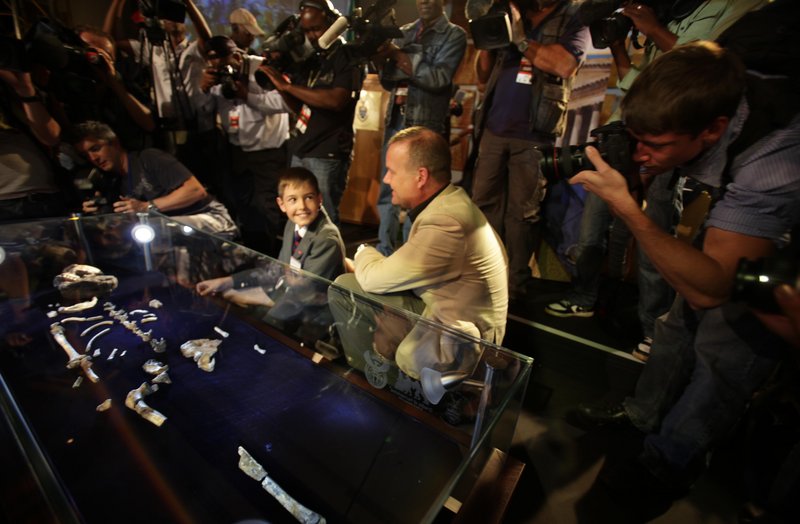LOS ANGELES — The middle-aged woman and the young boy were out hunting on the African plains or maybe looking for water in the midst of a drought when they fell into a sinkhole, dying almost instantly.
Shortly thereafter, a monsoon or flood washed them into a deeper basin, where they were covered with mud and rapidly fossilized.
In 2008, nearly 2 million years later, anthropologists discovered their nearly complete skeletons in the Malapa cave north of Johannesburg, South Africa, a find that experts have dubbed one of the most important of recent times. The hominid pair may be direct ancestors of humans or they may be from a closely related branch on the human evolutionary tree, South African researchers reported Thursday in the journal Science.
Either way, the rare discovery of nearly intact skeletons, experts agree, provides a key window into evolution during what is considered one of the key periods of human development, when hominids were changing from the apelike species known as Australopithecus into the more modern forms we now know as Homo.
The new skeletons are the only complete specimens that lie between the Australopithecus afarensis known as Lucy, dating from 3 million years ago, and the Homo erectus known as Turkana boy dating from 1.5 million years ago. “This gives us a good chance to look at the rates of change of various parts of the (body),” said biological anthropologist William Kimbel of Arizona State University. It is exceptionally rare to get such insights from single individuals in which all the body parts are together, he said.
“There are very few things that we can call a skeleton from that time period,” said biological anthropologist Christopher Ruff of the Johns Hopkins Medical School. Most often, researchers discover isolated craniums or jawbones or limbs and have to extrapolate what the species looked like.
The researchers have Google Earth and another young boy, paleoanthropologist Lee R. Berger’s 9-year-old son, Matthew, to thank for the discovery. Berger, from the University of the Witwatersrand in Johannesburg, used images from Google Earth to identify caves in the Cradle of Humankind World Heritage Site that might hold fossil deposits.
On his first visit to the Malapa cave, he suggested that Matthew look around outside the cave for fossils. Within 15 minutes, the boy returned carrying a block of stone bearing a hominid collarbone and a jawbone that apparently had been thrown out of the cave by miners.
Excited by the discovery, the team began excavating the cave and found the rest of that skeleton, of what appears to be an 11- to 12-year-old boy and another skeleton of a woman in her mid-30s, as well as skeletons of at least 25 species of animals, including antelope, mice, saber-toothed cats, a wildcat, a brown hyena, a wild dog and even a horse. They also found at least two other hominid skeletons, another woman and an infant, Berger said in a news conference, but they are not yet reporting on those.
All of the skeletons are in excellent shape because their fall into the pit protected them from scavengers and they were all fossilized rapidly.
The two “really remarkable skeletons” of primitive hominids that the team is reporting were quite surprising when they were completely unearthed, showing some characteristics of primitive Australopithecines and some of more modern Homo, Berger said.
The boy has a brain volume of about 420 cubic centimeters, less than the 510 cubic centimeters of the smallest known example of Homo and much less than the 1,200 to 1,600 cubic centimeters of modern humans. Both the woman and the boy were about 4 feet tall, about the same as Australopithecines, as were their relatively long arms. The woman weighed about 70 pounds and the boy about 60.
But the skeletons also had the smaller teeth, more prominent nose and less pronounced cheekbones of Homo erectus, as well as longer legs and changes in the pelvis characteristic of more modern hominids.
The lower limbs and the pelvis of the creatures, which the team has christened Australopithecus sediba, both indicate that the creature easily walked upright. Australopithecus means southern ape, while sediba is Sotho for natural spring, fountain or wellspring.
The long arms, however, indicated that it still climbed trees as well. Despite the name, then, “this is very different from Australopithecines,” Berger said.
There are three primary possibilities, Berger said. Australopithecus sediba is either a direct ancestor of Homo erectus, an ancestor of some of the variants within the Homo lineage, or “a very close side branch mimicking the earliest members of Homo.”
Berger noted that the team will hold a competition among African children to give a common name to the boy.
Send questions/comments to the editors.



Success. Please wait for the page to reload. If the page does not reload within 5 seconds, please refresh the page.
Enter your email and password to access comments.
Hi, to comment on stories you must . This profile is in addition to your subscription and website login.
Already have a commenting profile? .
Invalid username/password.
Please check your email to confirm and complete your registration.
Only subscribers are eligible to post comments. Please subscribe or login first for digital access. Here’s why.
Use the form below to reset your password. When you've submitted your account email, we will send an email with a reset code.